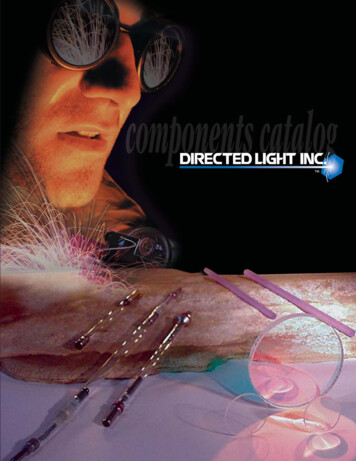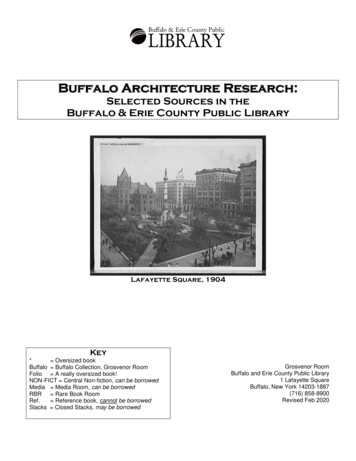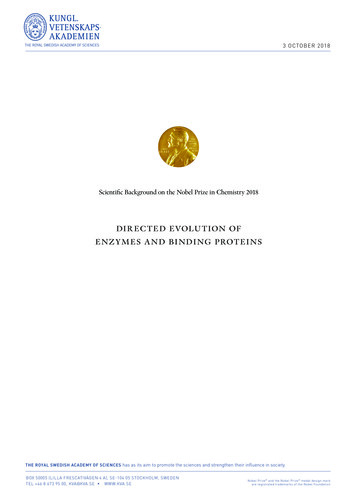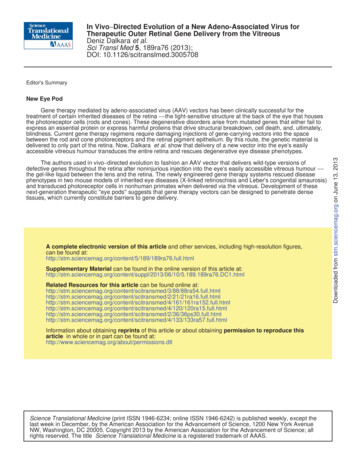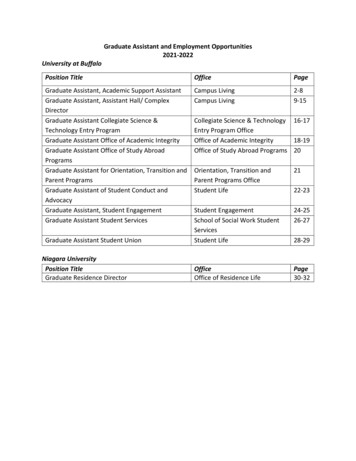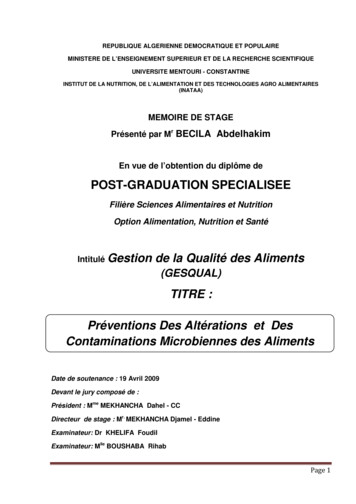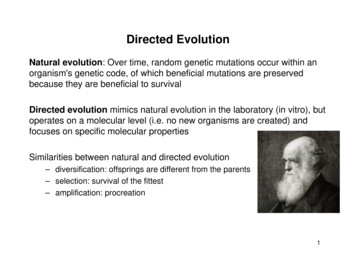
Transcription
Directed EvolutionNatural evolution: Over time, random genetic mutations occur within anorganism's genetic code, of which beneficial mutations are preservedbecause they are beneficial to survivalDirected evolution mimics natural evolution in the laboratory (in vitro), butoperates on a molecular level (i.e. no new organisms are created) andfocuses on specific molecular propertiesSimilarities between natural and directed evolution– diversification: offsprings are different from the parents– selection: survival of the fittest– amplification: procreation1
Benefits of directed evolutionDoes not require forethought of what type of mutations are beneficialLack of detailed knowledge is compensated for by use of a powerfulselection/screening method based on the concept of the survival of thefittestCustom selection schemes can be designed to fit the needs of an engineerVarious implementations of directed evolution––––platform Î choice of systemdiversification Î library constructionselection Î assay developmentamplification Î depend on the previous three2
What to engineer in the labEngineering goals may vary and can be applied to many different molecules– evolution of catalytic RNA/DNA– evolution of RNA/DNA aptamerafter 10 generations of selection, a 100fold increase in the ability to cut DNA106 fold increase in the ability toligate RNA backbone3Beaudry and Joyce, Science 257, 635 (1992)Bartel and Szostak, Science 261, 1411 (1993)
AptamerSELEX aptamer aptus (“to fit”) merShort fragment of RNA/DNA/peptide thatbinds a target molecule with high affinityvitamin B12solvent accessibledocking surfaceKd 90 nMSussman et al NSMB 7, 53 (2000) 10 2 – 10 5 sequence out of 10 13 randomlygenerate RNA binds dye moleculesEllington and Szostak, Nat 346, 818 (1990)4
Directed evolution and protein engineeringProtein molecules with altered structural and functional properties––––increase thermal stabilityintroduce a new functionality—e.g. engineer an enzymechange the topology or quaternary structurealter the details of existing properties—e.g. fluorescenceUnlike RNA/DNA, proteins cannot be amplified or propagated directlyDecoding the amino acid sequence requires sequencing the original DNAPhysical linkage between nucleic acid and protein is essential duringprotein engineering via directed evolution– genotype and phenotype need to be coupled– key to high throughput screening– protein needs to be “displayed” in order to be assayed (i.e. tested)» different methods of coupling result in different display platforms– cell-based functional assay5
Display technologies Phage displayBacterial displayYeast displaymRNA displayRibosomal display6
Phage display filamentous phage is a virus that infects bacteriathrough recombinant technology, a protein of interest can be introducedinto the viral genome (phagemid)virus expresses the foreign protein on the surfaceonce the protein is displayed, we can test for its activity, e.g. bindingaffinity, catalysis, etcfilamentousphageviral coatprotein III7Depertes, Biol Chem 383, 1107 (2002)
most common fitness criterion is affinity for a target receptor“biopanning” isolates phage particles with optimized binding affinity8
Peptide and protein librariesPeptides up to 40 residues– not all clones are represented– 15 residues Î 3 x 1019 possibilities– typically 109 clones in a .g. phosphatase, proteases, beta-lactamasehormones—e.g. human growth hormone, angiotensininhibitors—e.g. BPTI, cystatintoxins—e.g. ricin, ribotoxinreceptors—e.g. IgG binding domain of protein A and G, T cell receptorligands—e.g. SH3DNA binding protein—e.g. zinc finger proteincytokines—e.g. IL3, IL69Smith and Petrenko, Chem Rev 97, 391 (1997)
Engineering antibody Monoclonal antibodies (mAb) have a hugetherapeutic potential– cf. polyclonal antibodies Antibody with designed specificity findsapplications in science and biotechPhage display can either engineer newspecificity or fine-tune an existing oneThe functional part of an antibody is theantigen binding fragment (Fab), and thevariable domains of light and heavy chainsmay be covalently linked in a single chainantibody (scFv)CDR10
Simultaneous engineering of Ab and antigen pIII coat protein is required for infectivity, which is the physical basis ofselectionApply structural complementation assay to phage display by fusingantibody to the C-terminal fragment of pIII and antigen to the N-terminalfragmentCo-expression of the two will make the phage infective (selectivelyinfective phage, SIP) only when there is strong binding betweenantibody and antigen11Krebber et al, FEBS Lett 377, 227 (1995)
Affinity maturation Phage display is well-suited to optimize binding affinityHuman growth hormone binds hGH receptor (hGHbp) on cell surfaceusing two independent sites (1 and 2)– Cunningham and Wells, Science 24, 1081 (1989)– Mutations on hGH that increases affinity at site 1 and decreases affinityat site 2 is an effective hGHbp antagonist Mutational effects are often additive (Wells, Biochem 1990)– engineer high affinity mutant by combiningmutations selected for increased binding affinity12Lowman and Wells, JMB 234, 564 (1993)
Minimal IgG binding peptideThe B-domain of protein A from Staphlococcus aureus binds to the hingeregion of the constant domain of IgG (Fc) with Kd 10 – 50 nMZ-domain is part of B-domain consisting of 3 helicesCrystal structure shows that only two helicescontact IgG but the third helix is required toprovide stabilityEngineering a two helix version of the Z domainSystematic optimization of the exoface, intraface, and interfacei) exoface: between helix 1 and 2 with helix 3––degenerate library using “NNS” codonsrandomize four residues from H1 and H2 Î L20D, F31K13Braisted and Wells, PNAS 93, 5688 (1996)
ii) intraface: between helix 1 and 2–––incorporate the residues identified from exoface selectionrandomize five residues at the interface between H1 and H2three new residues together repack the coreiii) interface: between helix 1 and 2 with IgG–mutate 19 residues facingIgG Fc in groups of fourC exo and intraface mutant14
Shotgun scanning Shotgun scanning refers to large scale alanine scanning in phagedisplay formatOffers a high throughput method of analyzing the importance ofprotein side chainEach residue included in the study is represented as a 50-50 mix ofwild type and alanine in the libraryRatio of wt to ala is used to assess the role of the side chain15Avrantinis et al, ChemBioChem 3, 1229 (2002)
Determining protease specificity Selection made based on criteria other than binding affinityExpress a peptide library on phage and bind to immobilized receptorAddition of a protease will cleave phage particles expressing peptidesthat are preferentially cleaved by the proteaseReleased phage can be amplified and selection can be repeatedSequencing yields the consensus protease recognition sequence16Deperthes, Biol Chem 383, 1107 (2002)
Protease Substrate Knowledge of protease specificity helps designinhibitors Substrate specificity of subtilisin H54A mutantProtocol Construct a randomized peptide phage library– GPGGX5GGPG or GPAAX5AAPG (3.2x106) Bind to a matrix through an epitope (hGH) Add a protease to cleave– phage expressing a consensus proteasesequence is released– others remain bound Known substrate: AAHYTRQ Substrate mediated catalysisMatthews and Wells, Science 260, 1113 (1993)17
Stability Optimization Improve stability of scFv by phage display Incubate phage at high temperature or in thepresence of GdnHCl Replace solvent exposed hydrophobicresidues to polar residues In vivo, in vitro folding, affinity, solubility V48D mutation in 4-4-20 scFv improvesexpression by 25 fold, affinity unaffectedNieba et al, Protein Eng10, 435 (1997)Jung et al, JMB 294,18163 (1999)
Lipocalin Lipocalin is a family of beta-barrel proteinsoften involved in molecular transport– can bind hydrophobic molecules– include retinol binding protein, fatty acid bindingprotein, bilin binding protein– implicated in pheromone transport, olfaction, inflammation– low sequence homology, high structural similarity Some topologies are better suited to serve as a scaffold– small yet stable, soluble, good expression– tolerant to amino acid substitution and insertion– separation of a tertiary structure into a part responsible for stability, andanother part that allows structural variability– e.g. immunoglobulin, TIM barrel, lipocalin Structural stability has enabled introduction of affinity for novelcompounds—these are called “anticalin” in analogy to antibody19Skerra, Biochim Biophy Acta 1482, 337 (2000)
Metal binding site on the outer surface––––Zn binding in human carbonic anhydrase II comprises 3 Hismutate residues i) 46, 54, 56 or ii) 76, 78, 79 to Hisequilibrium dialysis to test zinc bindingatomic absorption spectrometry to measure the concentrationof free and bound metal ion– Kd i) 36 nM and ii) 440 nMFITCligandproteinRandomize 16 residues within the four loops of BBP––––display randomized proteins on phage and look for binding to fluoresceinKd 35 nMdeep ligand binding pocket can be reshapedsame library can be screened for other molecular targets20
Bacterial surface display Proteins can be similarly displayed on bacteriaTargeting a protein for expression on the surface of bacteria requiresa signaling peptide—e.g. first nine residues of E coli lipoprotein (Lpp)OmpA provides anchoring in the membranebeta-lactamase expressed on the surface is susceptible to proteolysisand can hydrolyze penicillin in the solution312Francisco et al, PNAS 89, 2713 (1992)21
Functional single chain antibody was expressed– antibody known to bind digoxinUse digoxin-FITC to visualize bindinga.b.c.d.negative controlpositive controltrypsin treatment prior to bindingpre-treatment with digoxine. diluted with 10 5 excess control E colif. after first round of sortingg. after second round of sorting22Francisco et al, PNAS 90, 10444 (1993)
FACS Fluorescence assisted cell sortingCells or beads with proteins on thesurfaceIndividual cells are fluorescently labeledusing antibody (or streptavidin)Substrate binding correlates withincreased fluorescenceLaser can inspect individual cells at highspeed ( 1,000 cells/sec) and sort thembased on a combination of color andintensitySorted cells represent an “enriched”population and the average affinity for thesubstrate is higher compared to the presort populationWorks with bacteria, yeast, andmammalian cells, but not with phage23
Bessette et al, PEDS 17, 731 (2004)24
Yeast surface displaySimilar to bacterial surface display but takes advantage of the eukaryoticexpression system available in yeast– post-translational modification, including glycosylation and disulfide formationEase of genetic manipulation in yeaste.g. ability to maintain multiple plasmids25Boder and Wittrup, NSB 15, 553 (1997)
initial libraryafter three rounds ofsorting andamplification26Boder et al, PNAS 97, 10701 (2000)
Engineering by SecretionSecretion efficiency from yeast correlates with stability– Kowalski et al, Biochemistry 36, 1264 (1998)wtC5/55wtC5/55mutants lacking various disulfide bonds27Hagihara and Kim, PNAS 99, 6619 (2002)
Single Chain MHC II Membrane protein that binds small foreign peptidesgenerated by degrading invading pathogens, e.g. virus,bacteria Recognized by the T cell receptor (TCR) to initiate achain of events that constitute acquired immunity MHC without peptide is unstable, difficult to synthesize Engineer a single chain version in order to studystructure-function relationship better, e.g. specificitydeterminants: scDR1αβ Improved folding rate and expressionEsteban and Zhao, JMB 340, 81 (2004)28
Engineering T Cell Receptor TCR recognizes each MHC-peptide combination Engineering stable single chain TCR not successful byother methods Yeast, being eukaryote, can synthesize large moleculesKieke et al, PNAS 96, 5651 (1999)Kieke et al, JMB 307, 1305 (2001)29
mRNA display Key to doing high throughput screening is the physical associationbetween the genomic and phenotypic dataGenomic information can also be RNAProtocol Covalently link mRNA to protein Protein can be assayed and sorted for function (e.g. binding) mRNA is amplified by PCR and/or sequencedin vitro transcription and translation30Roberts and Szostak, PNAS 94, 12297 (1997)
Randomized 80 amino acidsDiversity of 6 x 10 12randomlimited mutationsdiversity Enriched residues spread out throughout the protein—amino acidsthroughout the region contribute to the formation of folded structure31Keefer and Szostak, Nature 410, 715 (2001)
RNA ligase Find a protein to ligate two pieces of RNA Engineer on the zinc finger motif32Seelig and Szostak, Nature 447, 828 (2007)
Screen vs. Selection There are two types of high throughput assays: screen and selection Screen requires inspecting each member of the library one at a time– antibody library expressed on bacterial or yeast surface needs to bescreened by flow cytometry– enzymatic activity may be screened in 96 well plates– need a quantitative mechanism, e.g. fluorescence, catalysis Selection relies on a property that is essential for survival– antibody library on phage is used to select the particles with high affinity toan immobilized substrate– selectively infective phage– active engineered enzyme may be required for survival– may be used against a library that may be too large to screen– mRNA-peptide library can be as large as 1015Îat the rate of 104 mol/sec,would take 4,000 yrs.33
Designing a new topology Chorismate mutase is an essential enzyme required for the biosynthesisof aromatic amino acids Tyr and PheBacterial CM is a domain-exchanged homodimer; the active siteconsists of residues from both monomersEngineer a functional monomeric CM and thus change the enzymetopology– how important are the turn residues? L20E I77R 6 randomized residues34MacBeath et al, Science 279, 1958 (1998)
Diversity generation In nature, random mutations and recombination lead to geneticdiversificationDirection evolution requires a mechanism for introducing geneticvariationsRandom mutation–––––error prone PCRnucleoside analogsdegenerate oligonucleotidespropagation in strains lacking DNA repair capabilities: mutS, mutD, mutTgrowth in the presence of chemical mutagens: deamination, alkylationRecombination– DNA shuffling35
Error prone PCRDNA polymerases are naturally engineered to achieve high fidelity– pfu – 1 error in 10 6 to 10 7– Taq – 1 error in 10 4 to 10 5Create an artificial condition that is conducive of base misparing––––––use polymerase lacking proofreading activity—e.g. Taqhigh Mg concentrationsubstitution of Mn for Mg uneven concentrations of dATP, dCTP, dTTP, and dGTPvery low template concentrationorganic solvent—DMSO, alcoholUsed to create mutations at randomlocations—cf. site-directed mutagenesis36
Nucleoside analogAdding nonnatural dNTP during PCR leads to mutations because someof them base-pair 8-oxo-GTPZaccolo et al, JMB 255, 589 (1996)37
Degenerate oligonucleotidesTargeting mutations to a fixed location5’-ACT GGC GAT ATA AGT GAC GGA TTA CGT-3’5’-ACT GGC GAT NNN NNN NNN GGA TTA CGT-3’Deletion and insertion of amino acids5’-ACT GGC GAT ATA AGT GAC GGA TTA CGT-3’5’-ACT GGC GAT NNN --- NNN GGA TTA CGT-3’Use degenerate codons to control the type ofamino acidsNTN: M, L, I, V, FVAN: K, H, Q, E, N, DNAnySWG, CA, TKMRYG,A,A,C,HBVDNotNotNotNotTCGTGATC38Mena & Daugherty, PEDS 18, 559 (2005)
DNA shufflingMethod of recombining homologous genesProtocol– random digest with a nuclease– annealing to pair up fragments fromdifferent parents– PCR extension to reassemble full gene– limited to genes of high sequencesimilarity—otherwise the fragments annealwith other fragments from the same parentStemmer, Nature 370, 389 (1994)39
penicillin40
DNA shuffling between homologous proteins can rapidly evolve new function41Drummond et al, PNAS 102, 5380 (2005)Zhao et al, Nat Biotech 16, 258 (1998)
Summary of Directed Evolutionphage.bacteriabio-panningyeast42flow cytometryx-galcolorimetric assay
Directed evolution mimics natural evolution in the laboratory (in vitro), but operates on a molecular level (i.e. no new organisms are created) and focuses on specific molecular properties Similarities between natural and directed evolution - diversification: offsprings are different from the parents - selection: survival of the fittest


